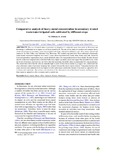Please use this identifier to cite or link to this item:
http://hdl.handle.net/10311/1105| Title: | Comparative analysis of heavy metal concentration in secondary treated wastewater irrigated soils cultivated by different crops |
| Authors: | Dikinya, O. Areola, O. |
| Keywords: | Heavy metals Maize Olive Spinach Tomato Wastewater |
| Issue Date: | Mar-2010 |
| Publisher: | Springer, http://link.springer.com/ |
| Citation: | Dikinya, O. & Areola, O. (2010) Comparative analysis of heavy metal concentration in secondary treated wastewater irrigated soils cultivated by different crops, International Journal of Environmental Science and Technology, Spring, Vol. 2, No. 2, pp. 337-346 |
| Abstract: | The use of treated urban wastewater for irrigation is a relatively recent innovation in Botswana and knowledge is still limited on its impact on soil heavy metal levels. The aim of this study is to analyze and compare heavy metal concentration in secondary wastewater irrigated soils being cultivated to different crops: olive, maize, spinach and tomato in the Glen Valley near Gaborone City, Botswana. The studied crop plots have been cultivated continuously under treated wastewater irrigation for at least 3 years. Most crop farms have sandy loam, loamy sand soils. Based on food and agriculture organization, heavy metal threshold values for crop production have been studied. Results showed that the wastewater irrigated soils in the Glen Valley have higher cadmium, nickel and copper than desirable levels, while the levels of mercury, lead and zinc are lower than the maximum threshold values recommended for crop production. The control sites show that the soils are naturally high in some of these heavy metals (e.g copper, zinc, nickel) and that crop cultivation under wastewater irrigation has actually lowered the heavy metal content. Comparing between the crops, mercury and cadmium levels are highest in soils under maize and decline linearly from maize to spinach to olive to tomato and control site. By contrast, concentrations of the other metals are at their lowest in maize and then increase from maize to spinach to olive to tomato and to control site. |
| URI: | http://hdl.handle.net/10311/1105 |
| ISSN: | 1735-1472 |
| Appears in Collections: | Research articles (Dept of Environmental Science) |
Files in This Item:
| File | Description | Size | Format | |
|---|---|---|---|---|
| ijest 2010 dikinya and areola.pdf | 669.29 kB | Adobe PDF |  View/Open |
Items in DSpace are protected by copyright, with all rights reserved, unless otherwise indicated.
